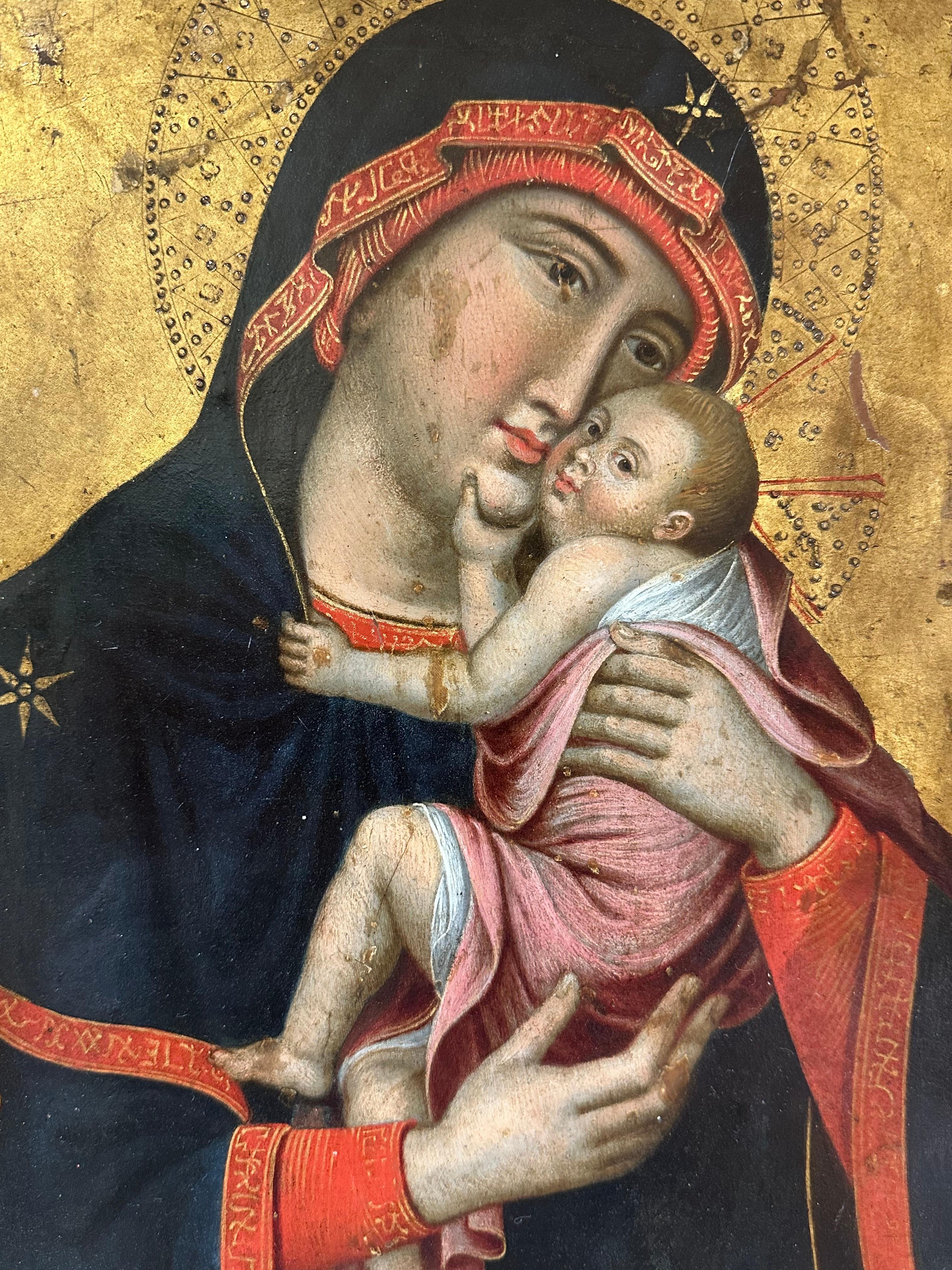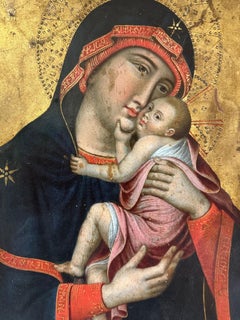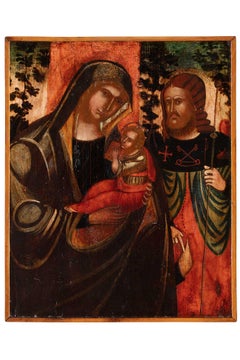Items Similar to Virgin of Kataphyge and St. John, after a Byzantine Bulgarian Icon 14th Century
Want more images or videos?
Request additional images or videos from the seller
1 of 11
Oliver SamsingerVirgin of Kataphyge and St. John, after a Byzantine Bulgarian Icon 14th Century
$2,620.08
£1,950.99
€2,200
CA$3,588.98
A$4,002.12
CHF 2,088.14
MX$49,107.55
NOK 26,578.65
SEK 25,182.70
DKK 16,747.80
Shipping
Retrieving quote...The 1stDibs Promise:
Authenticity Guarantee,
Money-Back Guarantee,
24-Hour Cancellation
About the Item
The Virgin of Kataphyge with Saint John the Evangelist, after a Bulgarian Byzantine icon of the 14th Century.
Egg tempera and gold leaf on gesso and wood.
Author: Oliver Samsinger
Measurements: (H) 39 x (W) 27 x (D) 2.5 cm. Weight: 1.8 Kg.
The original icon, in the Sofia National Gallery of Art, is a processional icon.
The positions of the Virgin and Saint John the Evangelist in this icon are reminiscent of a Crucifixion scene.
The Virgin bears the rare epithet of Kataphyge (Asylum).
Her maphorion gives the impression of austere elegance and she wears purple shoes, which was also a privilege of the Byzantine emperor to underline his status.
Saint John, depicted as an aged man, wears a himation that falls in light-colored folds.
The desire for help (“asylum”), and protection from the Mother of God links the epithet “Asylum” (on the gold background, to the left of her head) with her standard image and her position in the scene of the Crucifixion.
ABOUT THE ARTIST
Oliver Samsinger (Vienna, 1968) began to take an interest in icons in 1990. He undertakes several trips to Bulgaria, Greece, and Cyprus to see in situ the original works treasured in these three countries. This experience will be crucial in his life, since the studies carried out in Sofia, the Bulgarian capital, and his stay on Mount Athos constitute his greatest impulse and motivation to dedicate himself to making his own works, in a self-taught way, inspired by the models Russians and Byzantines that he had seen so closely, applying all his technical and artistic skills to his creations.
Oliver studies the ancient tradition for the realization of icons: wooden support, egg tempera paint, gold leaf, special varnishes ... it is a long and very elaborate procedure by means of which he makes very personal replicas of important icons of the orthodox church.
His icons have been exhibited in the Diocesan Museum of Vienna; also in the old Carmelite Church (KarmeliteKirche) and the Villa Wertheimstein in the same city between 2003 and 2006, and have also had successful presentations in Spain.
THE TECHNIQUE
This is how the artist sums up the technique used by him to create the icon:
“The aim of these steps is to create a durable painting. The icon is eternal.
The first step is to choose a support, traditionally made of wood, from the center of the trunk to avoid warping it. For this purpose, two hardwood bolts were often used on the back to give the picture panel additional stability.
Often a frame is milled out. Then the image carrier is sanded smooth and now 12 or 14 thin layers of gesso are applied and sanded smooth as well.
Then the preliminary drawing is applied and the drawing board is prepared with a special preparation called bolus. This bolus can be polished to a high gloss. Afterwards, the gold leaf is
"shot" with special brushes. It dries up within a few hours and can now be polished with an agate. Gold leaf is real 24 carat gold .
Now the actual process of painting begins. Egg tempera is made fresh from egg yolk, water, and a little vinegar. This is used to prepare the color pigments.
Tempera painting is done in numerous layers from dark to light.
When the icon is finished, it is left to dry for a few months and varnished with a special varnish called Olifa made from boiled linseed oil and other ingredients”.
About the Seller
5.0
Vetted Professional Seller
Every seller passes strict standards for authenticity and reliability
Established in 2002
1stDibs seller since 2017
67 sales on 1stDibs
Typical response time: <1 hour
- ShippingRetrieving quote...Shipping from: Segovia, Spain
- Return Policy
Authenticity Guarantee
In the unlikely event there’s an issue with an item’s authenticity, contact us within 1 year for a full refund. DetailsMoney-Back Guarantee
If your item is not as described, is damaged in transit, or does not arrive, contact us within 7 days for a full refund. Details24-Hour Cancellation
You have a 24-hour grace period in which to reconsider your purchase, with no questions asked.Vetted Professional Sellers
Our world-class sellers must adhere to strict standards for service and quality, maintaining the integrity of our listings.Price-Match Guarantee
If you find that a seller listed the same item for a lower price elsewhere, we’ll match it.Trusted Global Delivery
Our best-in-class carrier network provides specialized shipping options worldwide, including custom delivery.More From This Seller
View AllThe Virgin of Tijvin (after a Russian Icon in the style of the 18th century).
Located in Segovia, ES
The Virgin of Tijvin (after a Russian icon in the style of the 18th Century).
Egg tempera and gold leaf on gesso over wood.
Measurements in centimeters: 45 x 36.5 x 3 cm / In inch...
Category
1990s Byzantine Figurative Paintings
Materials
Gold Leaf
$1,895 Sale Price
20% Off
Virgin of Tijvin, after a Russian icon of the 17th Century.
Located in Segovia, ES
Virgin of Tijvin, after a Russian icon of the 17th century.
Egg tempera, gold leaf on gesso over a wooden board.
Measurements in centimeters: 44 x 33 x 3 cm / In inches: 17.32 x 12.99 x 1.18 "
Author: Oliver Samsinger...
Category
1990s Byzantine Mixed Media
Materials
Gold Leaf
Icon of Our Lady of Jerusalem with oklad by Oliver Samsinger
Located in Segovia, ES
Icon of Our Lady of Jerusalem.
Egg tempera on gesso and over a wooden board.
Dimensions in centimeters: 42 x 34 x 2 cm / In inches: 16.54 x 13-39 x 0-79 "
Author: Oliver Samsinger...
Category
1990s Byzantine Figurative Paintings
Materials
Brass
$2,743 Sale Price
20% Off
Saint John The Forerunner after a Russian Icon from the 16th Century
Located in Segovia, ES
Saint John, The Forerunner, after a Russian Icon from the 16th Century.
Tempera and gold leave on gesso over a wooden board.
Dimensions: (H) 33 x (W) 25,5 x (D) 4 cm.
Photos are included with the icon exposed to very different lighting, but all of them are natural.
John, The Forerunner, is depicted as an ascetic desert saint with a tousled beard and a coat made from camel hair. The expression that transmits his beautiful face is very intense.
This is how the artist sums up the technique used by him to create the icon:
“The aim of these steps is to create a durable painting. The icon is eternal.
The first step is to choose a support, traditionally made of wood, from the center of the trunk to avoid warping it. For this purpose, two hardwood bolts were often used on the back to give the picture panel additional stability.
Often a frame is milled out. Then the image carrier is sanded smooth and now 12 or 14 thin layers of gesso are applied and sanded smooth as well.
Then the preliminary drawing is applied and the drawing board is prepared with a special preparation called bolus. This bolus can be polished to a high gloss. Afterward, the gold leaf is
"shot" with special brushes. It dries up within a few hours and can now be polished with agate. Gold leaf is real 24-carat gold .
Now does the actual process of painting begins. Egg tempera is made fresh from egg yolk, water, and a little vinegar. This is used to prepare the color pigments.
Tempera painting is done in numerous layers from dark to light.
When the icon is finished, it is left to dry for a few months and varnished with a special varnish called Olifa made from boiled linseed oil and other ingredients”.
ABOUT THE ARTIST
Oliver Samsinger...
Category
1990s Byzantine Mixed Media
Materials
Gold Leaf
"Birth of Christ" after a Russian icon of the 15th century. Oliver Samsinger
Located in Segovia, ES
"Birth of Christ", after a Russian icon of the 15th century.
Tempera and gold leaves on gesso, wooden board. Dimensions: (H) 68 x (W) 52 x (D) 4 cm.
This icon sums up the events of the birth of Christ. At the top left the three wise men from the Orient approach on horses.
ABOUT THE ARTIST
Oliver...
Category
1990s Byzantine Mixed Media
Materials
Gold Leaf
$2,743 Sale Price
20% Off
The archangel Saint Michael, after an icon of the 14th century
Located in Segovia, ES
Archangel Saint Michael after an icon from Constantinople of the 14th Century.
Artist: Oliver Samsinger
Technique: Egg tempera on gesso and wood, with application of gold leaf
Dimens...
Category
2010s Byzantine Figurative Paintings
Materials
Gold Leaf
You May Also Like
Museum Quality Renaissance Masterpiece Virgin Mary & Infant Christ painting
Located in Cirencester, Gloucestershire
The Virgin Mary holding the infant Jesus
Italian 17th century
oil on copper, in tabernacle frame
Overall framed: 19 x 17 inches
Actual copper panel: 14.25 x 11 inches
Provenance: pr...
Category
17th Century Byzantine Figurative Paintings
Materials
Copper
Russian Icon of Madonna and Child
Located in Pasadena, TX
This is a giltwood Icon of the Madonna and Child. Made in Russia, it's hand painted and gilted.
Category
20th Century Russian Religious Items
Materials
Wood, Paint
15th Century by Circle of Nicolò Zafuri Madonna with Child Oil on Canvas
Located in Milano, Lombardia
Nicolò Zafuri (circle of) (documented in Candia between 1487 and 1500, died before 10 July 1501)
Title: Madonna with Child
Medium: Oil on panel
Dimensions: without frame 49 x 40 cm
...
Category
15th Century and Earlier Old Masters Portrait Paintings
Materials
Cotton, Cotton Canvas, Oil
Russian Icon "Saint Mother of God of Pokrov"
Located in Houston, TX
Russian Icon, oil on wood, with beautiful cloisonné enamel around. Icon is surrounded with floral motifs decorative insert that is placed into the thick carved wooden frame.
Icon is signed verso with dedication to the church that it was made for.
c. 1860s
23.5”h x 20.5”w, overall size is 47.5” x 34”
Writing on the back of the icon says:
"Painted family icon was donated to the church of the name of Pokrova of Virgin Mary with additions of flora and laurel and with 3 saints: Vasiliy the Great, Gregory the Theologian and John Chrysostom by people born at the village of Gubino and later by the merchant Vasiliy Miheev from Saint Petersburg with his wife Tatiana Yakovleva-Miheeva. Done in the memory of completion of this church with stone fence...
Category
1860s Other Art Style Figurative Paintings
Materials
Oil
19th C. Russian Icon Depicting St. Zossima & St. Savaati of Solovetsk
Located in Los Angeles, CA
This 19th-century Russian icon features St. Zossima and St. Savvati of the Solovetsky Monastery. The saints are depicted in a traditional Byzantine style, characterized by their elon...
Category
Antique 19th Century European Paintings
Materials
Wood
Wood Wall Hanging of Maesta Madonna and Christ Child after Cimabue, Italy
Located in Oklahoma City, OK
A fabulous pentagon wood wall hanging of the Madonna and child from Italy. This piece is created from wood, and has an applied print of Maesta, (Madonna enthroned with the Christ child by Cimabue) The edges feature a gold embossed design. The back includes metal hanging hardware.
Cimabue, also known as Cenni di Pepo...
Category
20th Century Italian Gothic Prints
Materials
Wood, Paper
$440 Sale Price
20% Off
More Ways To Browse
John Golding Painting
Antique St Johns
St John Oil Paintings
Icon Painting Gold
Painting Of The Virgin
Saint John Painting
Antique Icon Painting
Antique Sand Art
Antique Tempera Painting
Russian Icon Painting
Russian Icons Gold
Painting 14th Century
Byzantine Antique
Antique Olive Color
Mount Of Olives
Wooden Eggs
Crucifixion Paintings
Antique Gold Gesso Frame


